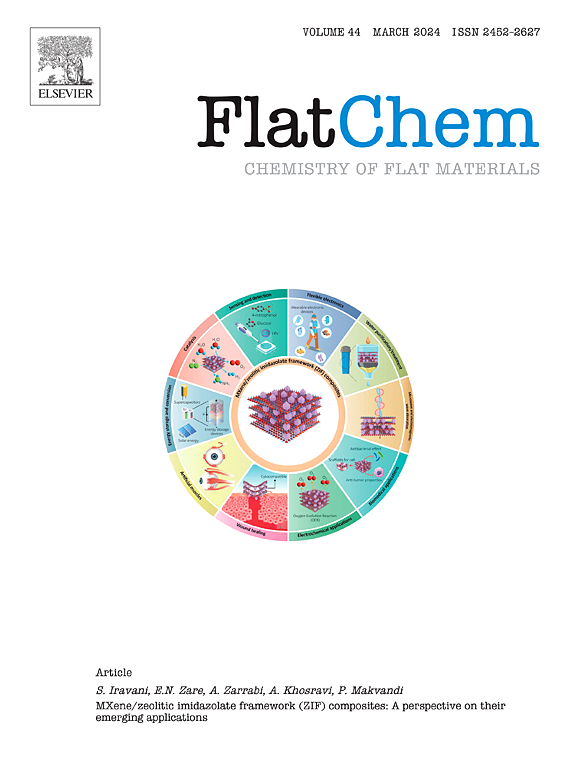新型环境友好型双z型SrTiO3/g-C3N4/ZnO异质结高效析氢和污水处理:优化、机制解释和毒性评估
IF 6.2
3区 材料科学
Q2 CHEMISTRY, PHYSICAL
引用次数: 0
摘要
本研究合成了一种新型的强效三元SrTiO₃/g-C₃N₄/ZnO (STCZ)光催化剂,并对其在可见光下光催化制氢和降解四环素(TC)的效率进行了表征。将优化后的40% -SrTiO₃/g-C₃N₄(STC)二元混合物添加到ZnO纳米颗粒上制备三元复合材料,并对其性能进行了系统评价。最优的35% -STCZ纳米复合材料的析氢速率为603.94 μmol·g−1·h−1,比STC二元光催化剂提高了2倍。在催化剂用量为0.65 g/L、TC浓度为28.24 mg/L、反应时间为71.98 min、pH为5.11的优化条件下,对TC的降解效率达到96%。综合材料表征,包括XRD, XPS, SEM, TEM, BET和UV-vis DRS分析,证实了35% -STCZ复合材料的成功合成和增强的光催化性能。此外,EIS, PL光谱和光电流测量表明,由于双Z-scheme异质结机制,有效的电荷分离和载流子迁移率提高。捕获实验和ESR分析表明,羟基(•OH)和超氧化物(•O₂−)自由基在TC的光催化降解中起关键作用,并通过LC-MS分析阐明了中间降解途径。毒性评价表明,光催化处理显著降低了TC及其副产物的生态影响。35% -STCZ复合材料表现出优异的稳定性,在连续5个循环中保持85%的光催化活性。此外,该催化剂在不同的水源中表现有效,强调了其实用性。这些发现突出了SrTiO₃/g-C₃N₄/ZnO光催化剂在环境修复和可持续制氢方面的双重应用潜力,为碳中和能源解决方案和水污染控制提供了一条有希望的途径。本文章由计算机程序翻译,如有差异,请以英文原文为准。

Novel environmentally benign dual Z-scheme SrTiO3/g-C3N4/ZnO heterojunction for efficient H2 evolution and polluted water treatment: Optimization, mechanism interpretations and toxicity assessment
In this study, a novel and robust ternary SrTiO₃/g-C₃N₄/ZnO (STCZ) photocatalyst was synthesized and characterized for its efficiency in photocatalytic hydrogen production and tetracycline (TC) degradation under visible light illumination. The ternary composite was prepared by incorporating an optimized 40 %-SrTiO₃/g-C₃N₄ (STC) binary mixture onto ZnO nanoparticles, and its performance was systematically evaluated. The optimal 35 %-STCZ nanocomposite demonstrated a remarkable hydrogen evolution rate of 603.94 μmol·g−1·h−1, representing a twofold increase compared to the STC binary photocatalyst. Furthermore, it achieved a 96 % TC degradation efficiency under the following optimized conditions: catalyst dosage of 0.65 g/L, TC concentration of 28.24 mg/L, reaction time of 71.98 min, and pH 5.11. Comprehensive material characterization, including XRD, XPS, SEM, TEM, BET, and UV–vis DRS analyses, confirmed the successful synthesis and enhanced photocatalytic properties of the 35 %-STCZ composite. Moreover, EIS, PL spectroscopy, and photocurrent measurements indicated efficient charge separation and improved carrier mobility, attributed to the dual Z-scheme heterojunction mechanism. Trapping experiments and ESR analysis revealed that hydroxyl (•OH) and superoxide (•O₂−) radicals played pivotal roles in the photocatalytic degradation of TC, with intermediate degradation pathways elucidated via LC-MS analysis. Toxicity assessments demonstrated that the photocatalytic treatment significantly reduced the ecological impact of TC and its byproducts. The 35 %-STCZ composite exhibited excellent stability, maintaining 85 % of its photocatalytic activity over five consecutive cycles for TC degradation. Additionally, the catalyst performed effectively across diverse water sources, underscoring its practical applicability. These findings highlight the potential of the SrTiO₃/g-C₃N₄/ZnO photocatalyst for dual applications in environmental remediation and sustainable hydrogen production, offering a promising pathway toward carbon-neutral energy solutions and water pollution control.
求助全文
通过发布文献求助,成功后即可免费获取论文全文。
去求助
来源期刊

FlatChem
Multiple-
CiteScore
8.40
自引率
6.50%
发文量
104
审稿时长
26 days
期刊介绍:
FlatChem - Chemistry of Flat Materials, a new voice in the community, publishes original and significant, cutting-edge research related to the chemistry of graphene and related 2D & layered materials. The overall aim of the journal is to combine the chemistry and applications of these materials, where the submission of communications, full papers, and concepts should contain chemistry in a materials context, which can be both experimental and/or theoretical. In addition to original research articles, FlatChem also offers reviews, minireviews, highlights and perspectives on the future of this research area with the scientific leaders in fields related to Flat Materials. Topics of interest include, but are not limited to, the following: -Design, synthesis, applications and investigation of graphene, graphene related materials and other 2D & layered materials (for example Silicene, Germanene, Phosphorene, MXenes, Boron nitride, Transition metal dichalcogenides) -Characterization of these materials using all forms of spectroscopy and microscopy techniques -Chemical modification or functionalization and dispersion of these materials, as well as interactions with other materials -Exploring the surface chemistry of these materials for applications in: Sensors or detectors in electrochemical/Lab on a Chip devices, Composite materials, Membranes, Environment technology, Catalysis for energy storage and conversion (for example fuel cells, supercapacitors, batteries, hydrogen storage), Biomedical technology (drug delivery, biosensing, bioimaging)
 求助内容:
求助内容: 应助结果提醒方式:
应助结果提醒方式:


